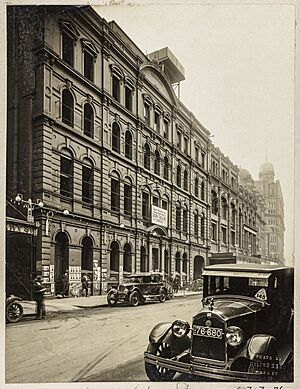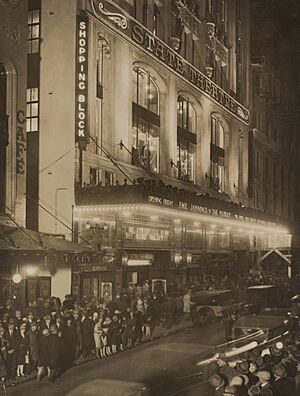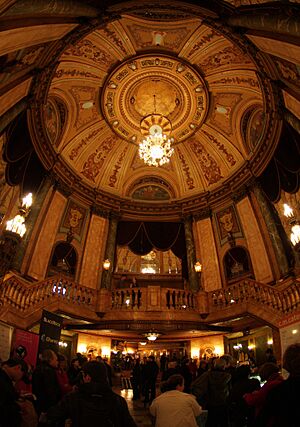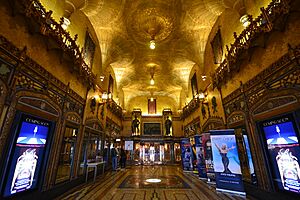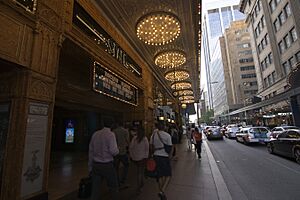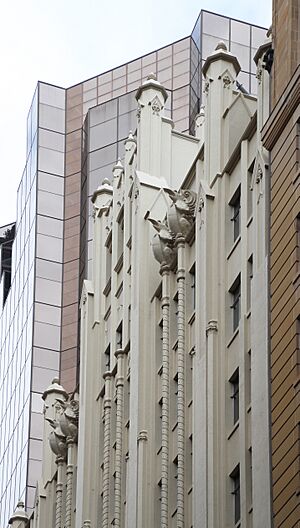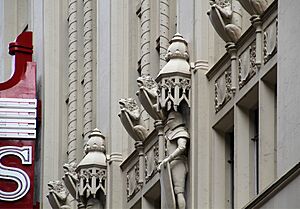State Theatre (Sydney) facts for kids
Quick facts for kids State Theatre |
|
|---|---|
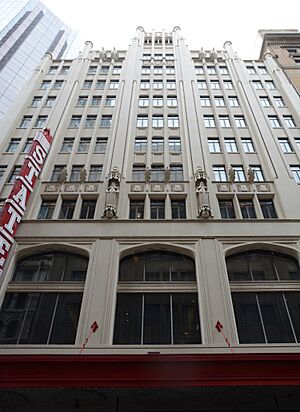
Facade from Market Street
|
|
| Location | 47–51 Market Street, Sydney, City of Sydney, New South Wales, Australia |
| Area | 2516 m² |
| Height | 56.8m |
| Design period | 1926 |
| Built | 1926–1929 |
| Built for | Union Theatres |
| Architect | Henry Eli White, John Eberson |
| Architectural style(s) | Modern Gothic, Neoclassical, Baroque, Art Deco and French Empire |
| Owner | EVT Limited |
| Official name: State Theatre; State Building; Wurlitzer Organ | |
| Type | State heritage (built) |
| Designated | 2 April 1999 |
| Reference no. | 446 |
| Type | Theatre |
| Category | Recreation and Entertainment |
| Builders | John Grant and Sons |
| Lua error in Module:Location_map at line 420: attempt to index field 'wikibase' (a nil value). | |
The State Theatre is a famous and historic theatre in Sydney, New South Wales, Australia. It is located at 47–51 Market Street in the city center. The theatre was designed by Henry Eli White with help from John Eberson. It was built between 1926 and 1929.
Today, the State Theatre is a busy place. It shows movies, hosts live plays, and features musical performances. Since 1974, it has been the main home for the yearly Sydney Film Festival. The theatre is also known as the State Building and Wurlitzer Organ. It is a privately owned building and was added to the New South Wales State Heritage Register in 1999.
The State Theatre has a special design with sloped seating and a large arch at the front of the stage, called a proscenium arch. It can seat up to 2,034 people. The seats are spread across three levels: 828 seats on the main floor (Stalls), 426 in the middle section (Mezzanine Lounge), and 780 seats on the top level (Dress Circle).
Contents
History of the State Theatre
How the Theatre Was Designed
The State Theatre was designed by Henry Eli White, a very important theatre architect from New Zealand who worked in Sydney. He designed about 120 theatres in Australia and New Zealand. The State Theatre is one of his best and most unique works.
Henry White worked with an American architect named John Eberson on the design. White visited the US to see Eberson's theatres. This trip helped him design the State Theatre without any columns blocking the view of the stage from the upper balconies. The inside of the theatre also shows Eberson's influence.
Building the Theatre
The Union Theatres company bought the land in 1926. This spot used to be where The Evening News newspaper offices were. Building the State Theatre started in 1927. The plan was to create a grand new theatre with 12 floors of shops above it, plus two basement levels.
The building site was dug out 14.6 meters (about 48 feet) deep. Workers removed a lot of stone and soil to make space for the theatre and its basements. The building reached a height of 56.8 meters (about 186 feet). Almost a million bricks, tons of cement, and a lot of steel and timber were used. By the time it was finished, the building cost a lot more than planned.
Opening Night
The State Theatre first opened its doors on 7 June 1929. Stuart Doyle, who owned Union Theatres, and architect Henry White imagined it as "The Empire's Greatest Theatre." It was built as a grand "picture palace" for movies, which were very popular at the time.
On opening night, people enjoyed "entertainment of unparalleled magnificence." The famous bandleader Will Prior performed. The theatre showed the film The Patriot, with Price Dunlavy playing the Wurlitzer organ.
The theatre originally had about 2,572 seats. While it wasn't as big as the State Theatre in Melbourne, it was much more decorated. Henry Eli White designed it with Gothic-style street fronts and a fancy lobby. Inside, it had a Neoclassical domed staircase and detailed foyers. The main auditorium was designed in a rich Baroque style with three levels of seating and a domed ceiling.
The first movie with sound, A Dangerous Woman, was shown on 29 June 1929. The last silent film, Evangeline, was screened on 6 December 1929. Early advertisements for movies also promoted live entertainment, like Will Prior’s State Band and the State Beauty Ballet.
The Great Depression and New Owners
Just two years after opening, the Union Theatres company faced money problems because of the Great Depression. In 1931, the company was sold. Greater Union Theatres Limited bought the State Theatre and has owned it ever since. This company is now known as EVT Limited.
Newsreels and World War II
In 1932, a special cinema for newsreels opened in the theatre's basement. This was the first of its kind in Australia. Newsreels were short films showing current events. The theatre also featured live performers like Australian singer Rene Maxwell.
During the World War II years, the State Theatre continued to provide entertainment. People could watch the latest news through regular screenings of the Movietone News. The theatre offered an escape from the war, showing films with popular actors like Cary Grant and Joan Crawford.
After World War II
After World War II ended in 1945, the State Theatre remained a popular place for entertainment in Sydney. In the 1950s, as Australia became more multicultural and people had more money, new suburbs grew. Television was not yet common, so many people still went to the State Theatre for live shows and movies. New Hollywood and Australian actors kept audiences interested. Films like Bend of the River (1952) and A Town Like Alice (1956) were shown.
The 1960s brought big changes to Australia, with new pop culture and protests against the Vietnam War. During these changing times, the State Theatre continued to offer a place for people to relax and be entertained. Movies shown reflected these changes, from Once More, with Feeling! in 1960 to more daring films by 1969.
The 1970s and Sydney Film Festival
In the 1970s, as more homes got televisions, filmmakers started making big "blockbuster" movies to bring people back to cinemas. The State Theatre often held premieres for these blockbusters, like The Godfather and Jaws. One very successful low-budget horror movie, Count Yorga, Vampire, was so popular that police had to help control the crowds outside!
In 1974, the State Theatre became the main venue for the Sydney Film Festival. It has hosted the festival every June since then, showing films for two to three weeks.
Live Theatre and Music
The 1980s were a time of big changes for the State Theatre. After being carefully restored, it reopened in 1980 with the concert film Divine Madness starring Bette Midler. Two years before, Bette Midler herself had performed live concerts there. In 1982, the famous movie E.T. The Extra-Terrestrial was shown at the State.
During this decade, the State Theatre returned to its roots, hosting many live acts and musical theatre performances. While many historic music venues in Sydney have been turned into other buildings, the State Theatre has remained a top venue. More renovations in the early 1990s made it even better.
Many famous stage musicals have been performed here, including Evita, Jesus Christ Superstar, and Anything Goes. Since the 1990s, many well-known performers have played at the State Theatre, such as Rudolph Nureyev, Shirley MacLaine, Whoopi Goldberg, and Harry Connick Jr.. Major music artists like Prince, Bob Dylan, Morrissey, Nick Cave, and Norah Jones have also performed on its stage.
Future Plans
In 2012, there were plans for a $32 million renovation to add an orchestra pit and more backstage space. This would have made the theatre even better for live performances. However, the plans did not go ahead because the theatre owners could not buy the building next door that was needed for the expansion.
Later, the theatre owners bought other nearby buildings. These purchases have given them more land around the theatre, which could allow for future improvements and additions.
What Makes the State Theatre Special
The State Theatre is amazing because of its unique design. As you walk from the street, you see Gothic designs, then enter a 14th-century Gothic Hall, and an Empire Room. After that, you find the dramatic Rotunda and French Empire-style foyers, leading to the grand main auditorium. This journey through different historical styles is very special.
The theatre was carefully restored in the 1980s, making its incredible beauty shine again. Even the public toilets have unique historical themes and designs in their waiting areas, which is very unusual and attractive.
The shopping area within the building also had high-quality Gothic designs, especially in the ground floor lift lobby with its glass display cases. In 1937, the Market Street shop fronts were changed to the Art Deco style, which was very modern at the time.
The theatre's lavish shopfronts, bright lights, and exciting event signs make Market Street look very rich and lively. There is also a small café inside, which has a modern Art Deco look but still keeps original features like the Gothic ceilings and mosaic floor tiles.
The State Theatrette, a smaller screening room, was once a popular place for showing newsreels and special films before television became common. Many people learned about world and national news there. The State Ballroom was also a popular place for dances for many decades.
The State Theatre was saved from demolition in the 1970s, when many historic buildings in Sydney were being torn down. Its protection shows how much the community values it. With its central location and rich history, the State Theatre is a well-loved entertainment spot in Sydney.
The State Theatre has a special 21-Rank Wurlitzer organ. It also has a huge Koh-i-Noor cut crystal chandelier, which is one of the largest in the world, weighing over four tonnes. The interior also features paintings by famous artists like William Dobell and Julian Ashton. The 11 floors above the theatre were originally a shopping arcade with 150 shops, all in the Gothic style. These floors are now used as offices.
Condition of the Theatre
The State Theatre is in excellent physical condition.
Heritage Importance
The State Theatre is very important to Australia's history. It was a major step in how cinemas were built in Australia. It was different from the "atmospheric cinemas" that were popular then, and it was one of the last grand cinemas built just before the Great Depression. It created a magical and imaginative space that perfectly captured the excitement of going to the movies at that time.
Its architectural design is unique in Australia. The way you move through the different styles, from the Gothic street front to the Baroque main auditorium, is unmatched in any 19th or 20th-century building in New South Wales. The interiors are beautifully designed and crafted, and they are still almost completely intact and in excellent condition.
The Gothic details that remain are unique and show very high-quality craftsmanship. The Gothic style was used consistently throughout the building, from the main foyers to the street front and even the upper levels of the shopping block. This consistent design helped set the scene for the lavish interiors.
The 1937 Art Deco shopfront changes on Market Street are also important. They are a rare example of Art Deco shop design from a time when the shopping block needed a new look.
The State Theatre was the most important venue for the Union Theatre company in Sydney. It was part of their big plan in the 1920s to build "Million Dollar Theatres" across the country. It is still the main theatre for the Greater Union organization and is linked to many people who have worked there, especially its founder, Stuart Doyle.
When it opened in 1929, the State Theatre was the ultimate entertainment venue in New South Wales. It remained a popular movie spot for many decades and hosted many movie premieres with big public events. Today, events like the annual Sydney Film Festival keep public interest high.
Other parts of the complex, like the multi-storey shopping arcade, ballroom, and theatrette, were also important in their original roles, even though they are not used for those purposes anymore. The State Theatrette was a popular place for newsreels, and the State Ballroom was a popular entertainment venue for many years.
The State Theatre Building is one of only two surviving theatres in Sydney designed by the famous architect Henry E. White. The other is the Capital Theatre.
The main public areas inside the theatre have one of the largest uses of scagliola (a material that looks like marble) in Australia. The plasterwork, especially in the Auditorium and around the Proscenium Arch, and other decorations like light fittings, show very high-quality design and craftsmanship from the 1920s. The Chandelier in the main Auditorium is one of the largest in Australia. There are also many original paintings and statues in the public foyers that are very artistic. The Wurlitzer Organ, though not working now, is a rare example of what was once a big part of the movie-going experience.
The State Theatre was listed on the New South Wales State Heritage Register in 1999.
- It shows how cultural history developed in New South Wales.
The State Theatre was a key part of the Union Theatre company's big expansion plan in the 1920s. It was a major step in cinema building in Australia, moving away from older styles. Its use over the years shows how movies and theatre became popular entertainment. It is still the main theatre for the Greater Union company and is connected to many people who worked there, especially its founder, Stuart Doyle. The original shopping arcade and basement areas also show how city planning and entertainment changed over time.
- It shows great artistic and technical skill.
The theatre's design was unique in the late 1920s, showing very high quality in design and construction. It created an amazing fantasy space that perfectly captured the spirit of going to the movies. The interiors are still almost completely intact and in excellent condition. The consistent use of the Gothic style throughout the building, from the street front to the main foyers and upper levels, is remarkable. The mix of Gothic and French Empire styles, rich details, and clever use of materials make it truly special.
- It is important to the community for social or cultural reasons.
When it opened in 1929, the State Theatre was the ultimate public entertainment venue in New South Wales. It was a popular movie spot for thousands of people for many decades and hosted many movie premieres. Events like the annual Sydney Film Festival keep it important to the public today.
- It can teach us about the cultural history of New South Wales.
The theatre's interiors have one of the largest uses of scagliola (imitation marble) in Australia. The quality of the plasterwork and other decorations is top-notch for the 1920s. The huge chandelier and the collection of original paintings and statues are very artistic. The Wurlitzer Organ, even if not working, is a rare example of what made going to the movies special. There are also many old photos and movie items that show what the theatre and entertainment were like throughout the 20th century.
- It is rare or unique in New South Wales.
The State Theatre complex is unique in Australia as a major early 20th-century entertainment venue with its high-quality Gothic and French Empire-inspired interiors. The Gothic details on the Market Street shop front are unique in Australia for how they introduce the dramatic theatre inside. The Gothic decoration of the ground floor lift foyer to the former Shopping Block is also unique. The 1920s Gothic design of the main building facades on Market and George Streets is rare in Sydney for a commercial building. The Art Deco panels on Market Street are also a rare example of shopfront design in Sydney.
- It shows the main features of similar places in New South Wales.
The State Theatre shows how American cinema designs were adopted in Australia in the 1920s to attract audiences. It is now both rare and a good example of the grand movie houses built in major Australian cities before the Great Depression. The vertical Shopping Block also represents a type of inner-city shopping that was tried in the 1920s but wasn't as successful as large department stores.
Gallery
-
The State Theatre ceiling with the huge Koh-i-Noor crystal chandelier.
-
A close-up of the bronze artwork showing St. George and the dragon.
-
A musical performance by Nick Cave and Colin Greenwood in April 2024.
See also
- Regent Theatre (Sydney)


